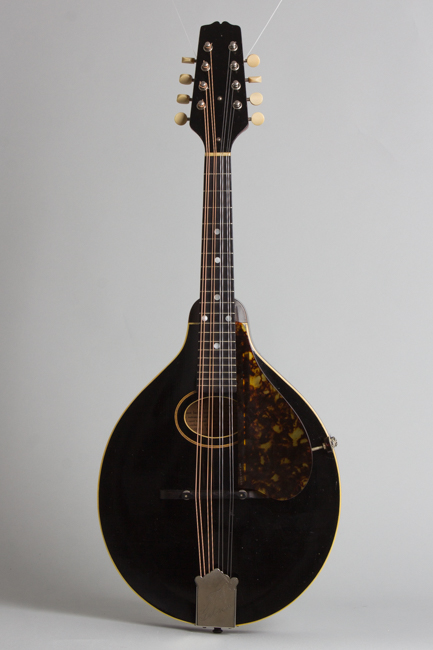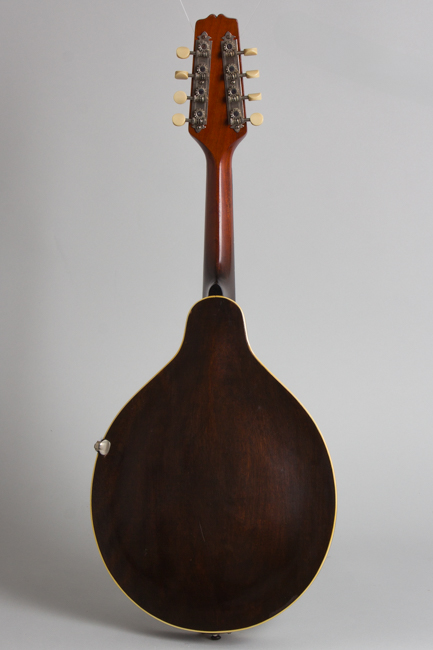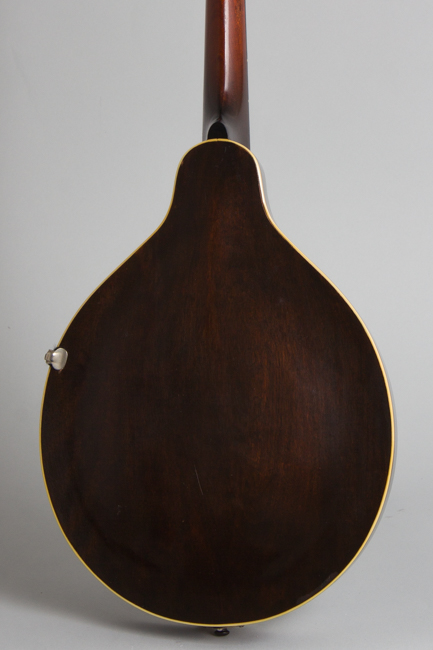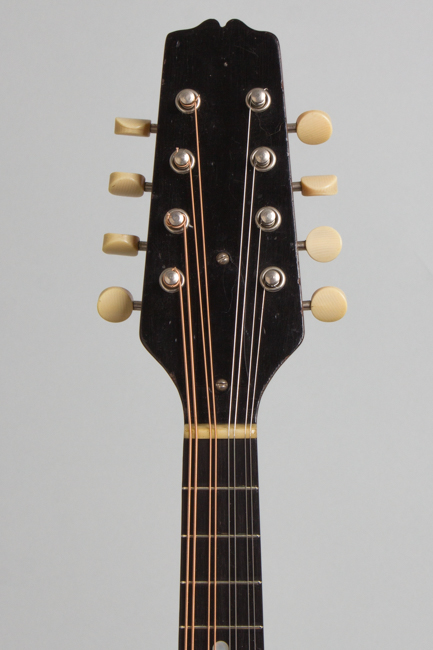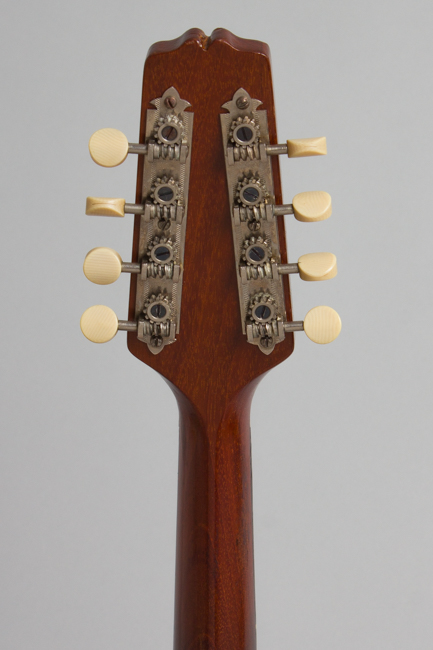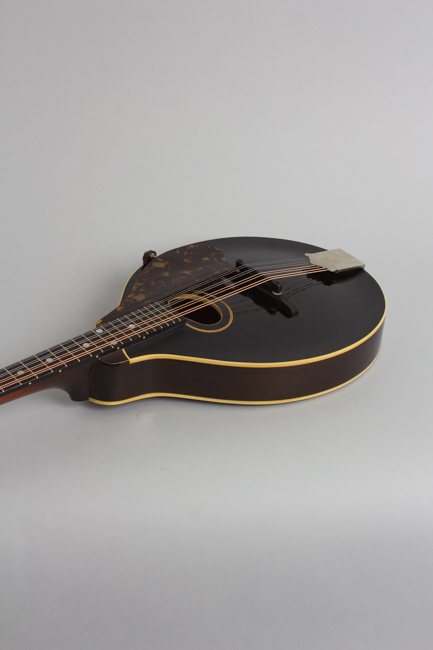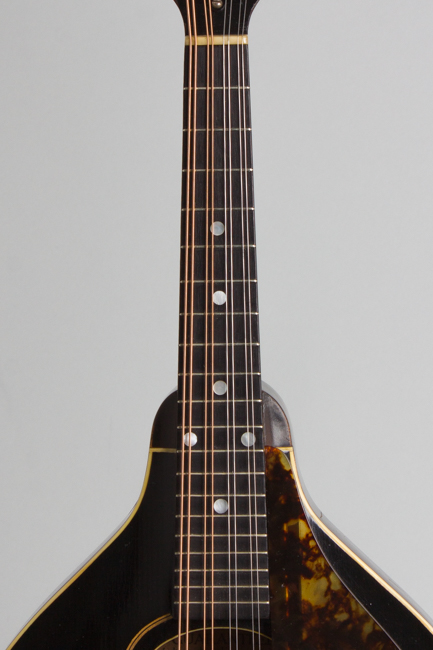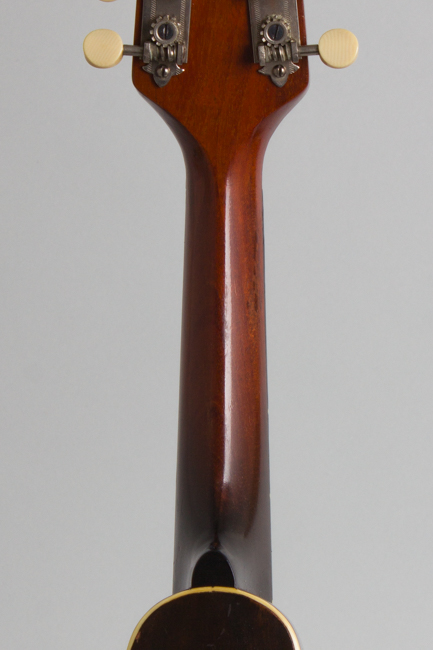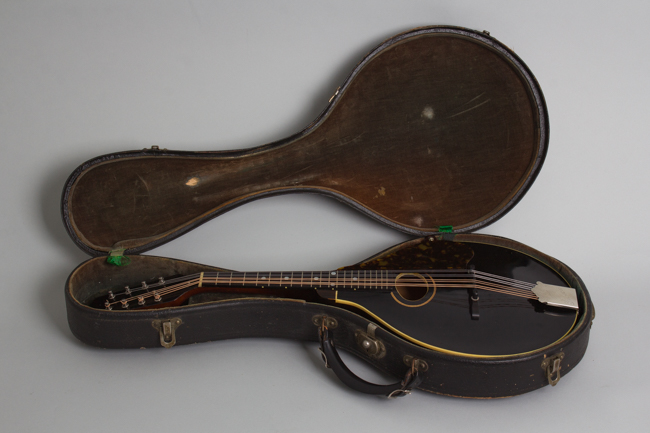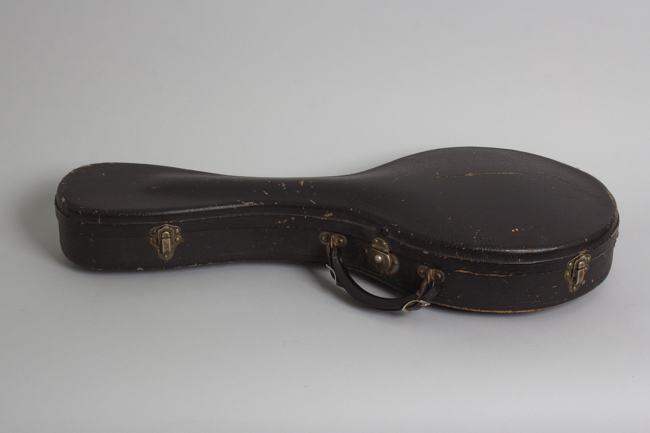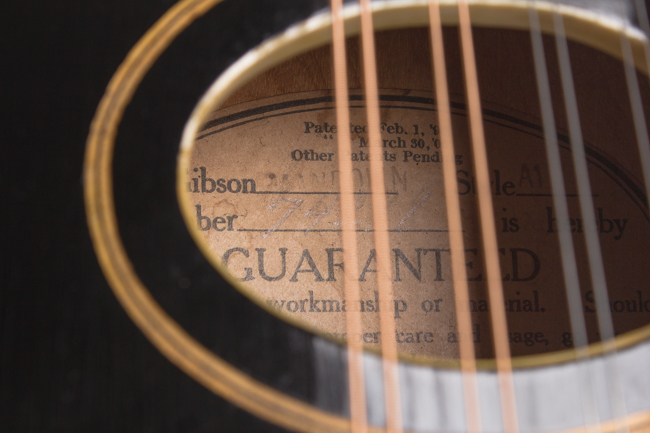Gibson Style A-1 Snakehead Carved Top Mandolin (1923)
This item is currently on hold.
Item # 13240
Prices subject to change without notice.
Gibson Style A-1 Snakehead Model Carved Top Mandolin (1923), made in Kalamazoo, Michigan, serial # 74218, black top, dark stained back and sides finish, birch back and sides, spruce top, mahogany neck with ebony fingerboard, original black hard shell case.
This is a great-playing and sounding, very nicely preserved Style A-1 mandolin made during the prime "Loar era" at Gibson. These "Snakeheads" are generally considered the best-sounding oval hole A style mandolins ever made, and this one certainly bears it out. This is a fine example of Gibson's craftsmanship at the apex of the mandolin era, just before the company's focus shifted to banjos and then guitars. This one has a Factory Order Number (FON) indicating it was built later in 1923, and the serial number penciled on the white oval label suggests it was shipped out close to the end of that year.
These "Snakehead" instruments are named for their Loar-designed peghead that angles inward towards the tip, a very functional and logical design feature inexplicably abandoned by Gibson several years later. They are revered for their unmatched tone and projection and have the advanced playability-enhancing features of the period including the slimmed-down one piece mahogany neck with an adjustable truss rod and the adjustable ebony bridge. The top on this A-1 bears a striking black lacquer finish, bound in white celluloid with a thin double inlaid wood soundhole ring. The tailpiece has the engraved "The Gibson" cover plate and the tuners are Waverly strips. The headstock does not bear a Gibson logo and the pickguard clamp is one of the last of the old 1910s pieces, soon replaced with a simple screwed-on bracket.
Lloyd Loar's tenure as acoustic engineer at Gibson has become so mythical that separating fact from fiction is difficult. Certainly the mandolin family instruments made during the period of his employment are the most perfectly realized in Gibson's history, and have become the template for most similar instruments since. Mandolins in particular of the "Loar era" show the influence of a master player on design and execution, although other Gibson employees (especially Thaddeus McHugh and Lewis A. Williams) actually engineered many of the technical improvements. Loar was primarily concerned with 'voicing' the instruments properly; the Master Model Style 5 line was his greatest contribution with their violin-style F-hole tops, but all Gibson instruments were refined at the same time. Even this basic "A-1" mandolin has sonic and playing improvements benefitting from "Master Loar's" input still evident today, 100+ years on and these distinctive "snakehead" A mandolins have become ever more sought-after by discerning players.
Overall length is 25 3/4 in. (65.4 cm.), 10 in. (25.4 cm.) wide, and 1 7/8 in. (4.8 cm.) in depth, measured at side of rim. Scale length is 14 in. (356 mm.). Width of nut is 1 1/16 in. (27 mm.).
This is a great playing and sounding "snakehead" with some light general wear but remaining nicely original overall. The finish is unaltered except for a small spot on the upper side of the back of the neck where a small thumbwear spot was smoothed out and lightly patched in. Otherwise it remains original showing some minor dings, scrapes and dents overall but really for over a century on the planet this is a pretty clean mandolin! The face of the headstock has a few dings and scrapes.
All seams are solid and there are no visible repairs to the wood. The adjustable ebony bridge, tuners, tailpiece and cover and pickguard/bracket assembly are all original. The original small frets and fingerboard show some light wear in the lower positions. Generally the mandolin appears not too much used over the last century, a splendid survivor of "Master Loar's" signature period with a fabulous sound still in the original HSC. Overall Excellent - Condition.
This is a great-playing and sounding, very nicely preserved Style A-1 mandolin made during the prime "Loar era" at Gibson. These "Snakeheads" are generally considered the best-sounding oval hole A style mandolins ever made, and this one certainly bears it out. This is a fine example of Gibson's craftsmanship at the apex of the mandolin era, just before the company's focus shifted to banjos and then guitars. This one has a Factory Order Number (FON) indicating it was built later in 1923, and the serial number penciled on the white oval label suggests it was shipped out close to the end of that year.
These "Snakehead" instruments are named for their Loar-designed peghead that angles inward towards the tip, a very functional and logical design feature inexplicably abandoned by Gibson several years later. They are revered for their unmatched tone and projection and have the advanced playability-enhancing features of the period including the slimmed-down one piece mahogany neck with an adjustable truss rod and the adjustable ebony bridge. The top on this A-1 bears a striking black lacquer finish, bound in white celluloid with a thin double inlaid wood soundhole ring. The tailpiece has the engraved "The Gibson" cover plate and the tuners are Waverly strips. The headstock does not bear a Gibson logo and the pickguard clamp is one of the last of the old 1910s pieces, soon replaced with a simple screwed-on bracket.
Lloyd Loar's tenure as acoustic engineer at Gibson has become so mythical that separating fact from fiction is difficult. Certainly the mandolin family instruments made during the period of his employment are the most perfectly realized in Gibson's history, and have become the template for most similar instruments since. Mandolins in particular of the "Loar era" show the influence of a master player on design and execution, although other Gibson employees (especially Thaddeus McHugh and Lewis A. Williams) actually engineered many of the technical improvements. Loar was primarily concerned with 'voicing' the instruments properly; the Master Model Style 5 line was his greatest contribution with their violin-style F-hole tops, but all Gibson instruments were refined at the same time. Even this basic "A-1" mandolin has sonic and playing improvements benefitting from "Master Loar's" input still evident today, 100+ years on and these distinctive "snakehead" A mandolins have become ever more sought-after by discerning players.
Overall length is 25 3/4 in. (65.4 cm.), 10 in. (25.4 cm.) wide, and 1 7/8 in. (4.8 cm.) in depth, measured at side of rim. Scale length is 14 in. (356 mm.). Width of nut is 1 1/16 in. (27 mm.).
This is a great playing and sounding "snakehead" with some light general wear but remaining nicely original overall. The finish is unaltered except for a small spot on the upper side of the back of the neck where a small thumbwear spot was smoothed out and lightly patched in. Otherwise it remains original showing some minor dings, scrapes and dents overall but really for over a century on the planet this is a pretty clean mandolin! The face of the headstock has a few dings and scrapes.
All seams are solid and there are no visible repairs to the wood. The adjustable ebony bridge, tuners, tailpiece and cover and pickguard/bracket assembly are all original. The original small frets and fingerboard show some light wear in the lower positions. Generally the mandolin appears not too much used over the last century, a splendid survivor of "Master Loar's" signature period with a fabulous sound still in the original HSC. Overall Excellent - Condition.
